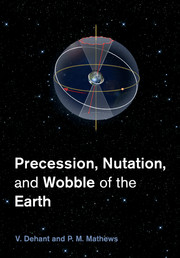Book contents
- Frontmatter
- Contents
- Preface
- List of abbreviations
- 1 Introduction – Fundamental definitions – Motivation
- 2 Concepts and elementary theory
- 3 Reference systems and frames
- 4 Observational techniques – ephemerides
- 5 Rigid Earth precession and nutation
- 6 Deformable Earth – Love numbers
- 7 Nutations of a non-rigid Earth
- 8 Anelasticity
- 9 Ocean and atmospheric corrections
- 10 Refinements of non-rigid nutation
- 11 Comparison observation-theory
- 12 Conventions
- 13 Mars nutations
- Appendix A Rotation representation
- Appendix B Clairaut theory
- Appendix C Definitions of equinoxes
- Bibliography
- Index
9 - Ocean and atmospheric corrections
Published online by Cambridge University Press: 05 May 2015
- Frontmatter
- Contents
- Preface
- List of abbreviations
- 1 Introduction – Fundamental definitions – Motivation
- 2 Concepts and elementary theory
- 3 Reference systems and frames
- 4 Observational techniques – ephemerides
- 5 Rigid Earth precession and nutation
- 6 Deformable Earth – Love numbers
- 7 Nutations of a non-rigid Earth
- 8 Anelasticity
- 9 Ocean and atmospheric corrections
- 10 Refinements of non-rigid nutation
- 11 Comparison observation-theory
- 12 Conventions
- 13 Mars nutations
- Appendix A Rotation representation
- Appendix B Clairaut theory
- Appendix C Definitions of equinoxes
- Bibliography
- Index
Summary
The pressure exerted on the Earth's crust by the atmosphere and the oceans is spatially non-uniform and undergoes significant temporal variations; it produces a variable torque on the Earth, which causes perturbations in Earth rotation. Additional perturbations take place as a result of the transfer of angular momentum from the winds and ocean currents to the solid Earth and vice versa. Both these effects must be taken into account when seeking to achieve high accuracy in computations of nutation, polar motion, and LOD variations.
The temporal and spatial variations in the atmospheric conditions are caused by the thermal forcing of the atmosphere by the variations in temperature of the continental and oceanic surfaces due to the diurnal and seasonal variations of the incident solar radiation, together with direct absorption by the atmosphere and secondary effects like evaporation from the oceans and cloud coverage. The bulk of the atmospheric (and oceanic) variations are non-periodic in nature; but the variations include periodic changes, referred to as atmospheric tides, which have been observed (Chapman and Lindzen, 1970). The largest of these tides have periods of one half of a solar day and one solar day, for readily understandable reasons. The retrograde diurnal part of these and other components of the tides with frequencies in the retrograde diurnal band evidently influence the low frequency nutations. The non-periodic part of the atmospheric variations contributes a continuum part to the spectrum of Earth rotation variations. The atmosphere is subject to gravitational forcing too, but this is much too weak to be of any consequence.
Gravitational forcing of the oceans, on the other hand, is far from ignorable: it produces ocean tides at the various tidal frequencies, which make a significant contribution to nutation amplitudes. Periodic forcing of the oceans by the atmosphere and periodic thermal effects also are of relevance.
This chapter aims at presenting the theoretical approaches to the treatment of atmospheric and oceanic effects on nutation.
- Type
- Chapter
- Information
- Precession, Nutation and Wobble of the Earth , pp. 338 - 369Publisher: Cambridge University PressPrint publication year: 2015



